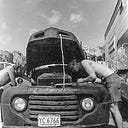This Day in History
December 30th
1903 — Iroquois Theater Fire. The fire at the Chicago theater remains the deadliest single building fire in U.S. history. The theater had only been open for a month and was hailed for its architectural splendor. It also had been advertised as “absolutely fireproof.” In truth many safety regulations had been ignored and the fire warden was told he would be dismissed if he reported it. A design flaw was that the theater had only one entrance. All patrons entering and exiting were funneled onto one wide staircase.
The theater’s designated capacity was 1,602. Above the main floor were two balcony levels. An overflow crowd of between 2,100 and 2,200, with many seated or standing in the aisles, was in attendance at the Wednesday’s matinee performance. An arc light ignited a curtain and the fire quickly spread upwards to an area above the stage where thousands of square feet of flammable canvas scenery props were stored. The crowd panicked as the fire spread overhead.
The famous entertainer, Eddie Foy, was on the bill that day. With flaming scenery falling around him, he stood on stage and tried to calm the panicked crowd. He later noted he had never seen so many women and children in an audience. The sad toll that day was 602 dead, perhaps even more because some bodies had been removed from the scene. That’s a higher death toll than the more famous Chicago Fire that destroyed much of the city.
Public outcry brought criminal charges but due to the influence of money and political connections, all charges were eventually dismissed.
This tragic incident could stand as an argument against those who decry government regulations. Then again, what with lawyers, construction workers to rebuild the theater, hospital workers, not to mention morticians, lack of stringent regulations was beneficial to that all important category, jobs.
1917 — The temperature dropped to -32F in Mountain City, Tennessee, and -37F in Lewisburg, West Virginia, record lows for each state. In 1933 the temperature fell to -50F in Bloomfield, Vermont, and in 1968 it was -48F in Mazama, Washington, also state records. The Scottish Highlands also recorded their lowest temperature on this date, -27.2C, which is -17F.
Seems December 30th is a very cold date. Minnesota’s state record is -60F, recorded in the small town of Tower, up on the Iron Range. The coldest I’ve even been in was around -40F. We had had the brilliant idea of going ice fishing at the time. The folly of that idea was quickly revealed to us.
Another time the temp was hovering around -30F when a friend and I were in danger of losing our heating source. However we still had electricity. It occurred to us that it was approximately 70 degrees warmer inside the refrigerator than outside. So if it came down to survival we decided we could just remove the shelving from the refrigerator and take turns climbing inside to warm up. Maybe I should mention that alcohol did play a part in this reasoning.
2003 — U.S. Attorney John Ashcroft recuses himself from CIA leak investigation. Former U.S. Ambassador Joseph Wilson had criticized the Bush administration over the evidence it had presented in justifying the Iraq War. Shortly thereafter it was publicly leaked that his wife, Valerie Plame, was an undercover CIA operative. Fifteen times since 1989 have U.S. Attorneys recused themselves from cases. Most of the time it was because they had some connection, however remote, to the case or persons involved. Ashcroft’s reason was his close ties to senior White House aides, where it was suspected the leak occurred in retaliation to Wilson’s criticism. Deputy Attorney James Comey became acting Attorney General and he appointed a special prosecutor to lead an investigation.
So, it appears this isn’t the first time James Comey has found himself all tangled up in a witch-hunt.
Birthdays:
1928 — Elias McDaniel, AKA Bo Diddley, was one of the pioneers of rock and roll music in the 1950s. The beat of his music was influential to many rock artists following in his wake, from Elvis Presley and the Rolling Stones to the Clash.
The song, “Bo Diddley”, to me, is still a rock and roll anthem. I find the beat as infectious today as I did when I was a teenager.
1935 — Sandy Koufax. Baseball Hall of Fame pitcher for the Dodgers. Despite a relatively short career, 12 seasons and only 165 victories, Koufax is regarded as one of the greatest pitchers of all time. A left-handed pitcher, he played for the Dodgers in both Brooklyn and Los Angeles. Koufax pitched four no-hitters and one perfect game. As an eighteen year old, he was discovered by Brooklyn scout Al Campanis. A quote from Campanis about watching Koufax pitch for the first time.“There are two times in my life the hair on my arms has stood up: The first time I saw the ceiling of the Sistene Chapeland the second time, I saw Sandy Koufax throw a fastball.” Koufax was forced to retire prematurely because of arthritis in his left elbow.
A great pitcher, although I never completely warmed up to him because he beat the Minnesota Twins in the seventh game of the 1965 World Series.
1942 — Mike Nesmith. Musician. One of the four members of the fabricated pop group, The Monkees. Incidentally, one other member of the group, Davy Jones, was also born on 12/30/42. What’s far more interesting however is that Nesmith’s mother was the inventor of Liquid Paper, that white stuff used to cover up a mistake used when typing. A single mom, she got a job as a typist. Apparently she wasn’t very good at it, and at night in a garage came up with the ingenious invention.
With the coming of the computer age, I hazard a guess that many Millenniums have never heard of this product.
Sources:
